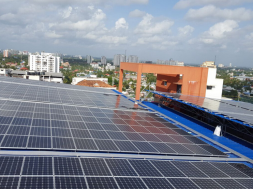
Without getting excessively technical, basically, the entire reason of AI is a machine emulating the human brain. The machine can learn and adjust to various situations, and as time passes, the machine gets smarter and responds diversely to accomplish better outcomes.
A one of a kind opportunity exists to apply AI to a particular part of the clean energy value chain: materials. Materials fill in as the structure blocks of clean energy, for example, the solar cells that make up the photovoltaic panels found on rooftops. Enhancing the materials used to manufacture parts of clean energy is significant on the grounds that current materials are frequently lethal, non-earth rich, and require carbon-concentrated processing.
This situation shows an opportunity for the clean energy manufacturing sector. Applying AI to the advancement of new materials can decrease embedded emissions, toxicity and costs while saving researchers valuable time in the lab. Experiments done by trial-and-error are frequently rehashed a lot of times before a breakthrough happens. Rather, AI could automate complex logical tasks and empower analysts to concentrate on tasks that require more creativity and ingenuity.
Utilizing AI along these lines can give producers an edge. Manufacturers will in general put resources into upgrading downstream production capacities, which has prompted a few AI applications in sensor innovations and process optimisation. Utilizing AI for upstream design purposes, nonetheless, is an undiscovered business opportunity that could decrease the time it takes to find new materials, opening up capital for deployment and commercialisation strategies.
In July 2018, Curtis Berlinguette, a materials scientist at the University of British Columbia in Vancouver, Canada, acknowledged he was burning through his graduate student’s time and ability. He had asked her to refine a key material in solar cells to boost its electrical conductivity. In any case, the number of potential changes was overpowering, from spiking the formula with hints of metals and different added substances to shifting the heating and drying times. According to Berlinguette, there are such a significant number of things you can go transform, you can rapidly experience 10 million [designs] you can test.
So, he and associates re-appropriated the effort to a single-armed robot overseen by an artificial intelligence (AI) algorithm. Named Ada, the robot blended various solutions, cast them in films, performed heat medicines and other processing steps, tried the film’s conductivity, assessed their microstructure, and logged the outcomes. The AI deciphered each examination and figured out what to blend next. At a meeting of the Materials Research Society (MRS) a week ago, Berlinguette revealed that the system immediately homed in on a formula and heating conditions that made defect-free films perfect for solar cells. What used to take them 9 months presently takes 5 days.
Ada could change how clean energy is made at a small amount of time and cost. Via autonomously testing materials at high computing forces, Ada plans to make solar panels stronger and to transform carbon dioxide into valuable fuels.
Ada is a part of a broader initiative under Mission Innovation, a global collaboration of 23 countries and the European Union, to deliver materials acceleration platforms (MAPs) far and wide. Canada and Mexico are driving this strategic initiative as co-leads of the Clean Energy Materials Innovation Challenge, putting resources into the solution to meet a rising ecological and industrial need. This innovation will soon be put up in a few different nations, making a worldwide network of robotics platforms tackling specific regional and corporate applications.
Robots have already made a difference. They are currently generally used to blend many somewhat various recipes for a material, store them on single wafers or different platforms, and afterward process and test them all the while. In any case, basically trudging through recipe after the recipe is a moderate course to a breakthrough. High throughput is an approach to do heaps of experiments, however, not a great deal of development.
To speed the procedure, numerous teams have included computer modeling to foresee the equation of likely pearls. “We’re seeing a torrential slide of exciting materials originating from the forecast,” says Kristin Persson of Lawrence Berkeley National Laboratory (LBNL) in California, who runs a large-scale prediction enterprise known as the Materials Project. However, those frameworks still commonly depend on graduate students or experienced researchers to assess the consequences of trials and decide how to continue. However, Individuals still need to do things like rest and eat.
Governments are making the first move on AI-empowered clean energy materials disclosure, flagging this is a region of key national and worldwide interest. Public risk capital drives down expenses for industry, empowering the more extensive adoption of AI in cutting edge producing. Making clean energy materials less expensive, cleaner, and increasingly solid isn’t useful for the earth, yet in addition useful for business.















